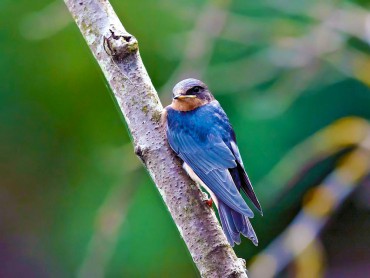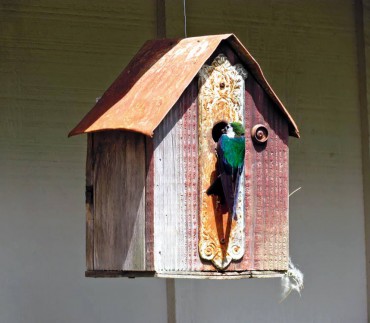
Poulsbo’s Fourth of July fireworks light up the sky over Liberty Bay on July 3. Thousands of watchers come to town. But not everyone enjoys the noisy and colorful display. Dozens of purple martins occupying their nesting gourds at Oyster Plant Park find themselves surrounded by crowds of excited onlookers.
What these birds think of the explosions and flashing lights is anyone’s guess. They’ve been putting up with it for over a decade and every year, more young martins are successfully fledged.
Purple martins are the largest member in the swallow family. Like others in that family, they are raising their broods later than other bird species.
A swallow’s diet is made up of flying insects. It takes a large amount of bugs to raise three or four offspring as well as feed themselves. The cold weather common in late spring doesn’t encourage these birds to begin nesting until the weather is warm enough to produce an abundant bug population.
There are six swallow species that nest throughout the West Sound area and the rest of Western Washington. They are attracted to wide-open areas, where they have free flying space in their pursuit of bugs. They can be found swooping over golf courses, both salt or fresh water, tidal flats, large fields and plant-filled gardens.

Most, but not all, are cavity-nesting birds. For this reason, some will use manmade birdhouses.
Purple martins are attracted to commercial gourds. These are replicated to look like the large, natural gourds grown in the eastern part of the country. Native Americans are reputed to have started the practice of putting up these gourds in order to attract the insect-eating martins.
Other swallows that use birdhouses are the tree and violet-green. Violet-green swallows are one of the birds that have suffered due to the large house sparrow population. House sparrows, a nonnative species, usurped many of the violet-green nesting places. The design of a different birdhouse encouraged them to return to places they had been driven from.
Instead of a round opening on the front of the house, an elongated diamond shape is used. At the center of the opening, it should measure, top to bottom, exactly 7/8 inches. The width of the opening should be 3 1/2 inches across.
This size allows the swallow to enter the house but the house sparrow, with its larger head, is kept out. There are variations on the shape of this opening but the 7/8-inch top-to-bottom measurement and the width of 3 1/2 inches are critical. The size of the width is dictated by the swallow’s wide shoulders. It allows it to get through the restricted opening.
Tree swallows often, but not always, nest near water. Lakes and even some salt-water areas attract this bird. They also come into conflict with the house sparrows but have better luck due to their slightly larger size and what appears to be a more aggressive personality. The three swallow species mentioned here are the only ones that will use manmade nesting structures.
Barn swallows will nest on manmade buildings but they construct their nests on horizontal surfaces like the beams in barns, open carports or garages, and even gazeboes.
Cliff swallows resemble the barn swallow but when it comes to nesting, they build their mud nests on the sides of buildings or cliffs. They also nest in colonies, and activity during summer nesting season is intense.
The birds fasten their mud nests on the vertical sides of buildings when tall cliffs aren’t available. They gather daubs of mud wherever they can find it and create clusters of “mud houses” to raise their broods in. Both barn swallows and cliff swallows will raise two broods a season.
Probably the least known swallow to nest in Western Washington is the rough-winged. These birds search for nesting places in the sides of banks along bodies of fresh or salt water. Rough-winged swallows are more commonly seen in less populated areas but will nest near towns or cities where sandy banks or cliffs are found along water.
These open areas near fresh or salt water provide the birds with the insect population all swallows depend on. Their nests are constructed in tunnels made by other birds, like the belted kingfisher. Resident kingfishers nest early in the spring, making it possible for the late-nesting rough-wings to move into the burrows the larger birds dug in the sandy cliffs.
Spring is nesting time for most birds but the swallows have a restricted diet. Their dependency on an abundant bug population demands that they nest later than the other bird species. They make it possible for us to enjoy nesting birds well into late summer.
Some of the best swallow watching can be found in the many parks throughout West Sound. This region’s waterfront setting provides numerous opportunities to enjoy these birds of summer.


























Comments